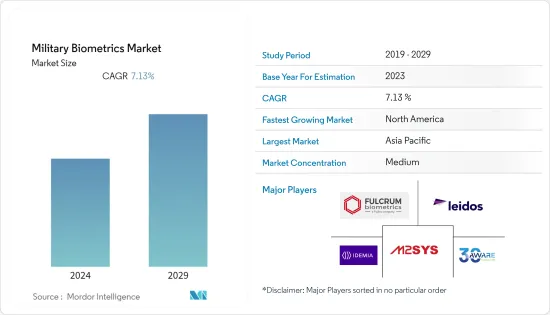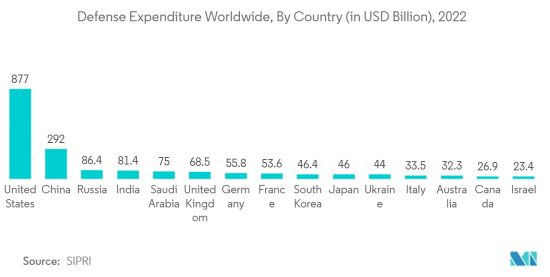 |
市场调查报告书
商品编码
1404385
军事生物辨识市场占有率分析、产业趋势与统计、2024-2029 年成长预测Military Biometrics - Market Share Analysis, Industry Trends & Statistics, Growth Forecasts 2024 - 2029 |
||||||
※ 本网页内容可能与最新版本有所差异。详细情况请与我们联繫。
2024 年,军事生物辨识市场价值为 528.3 亿美元,预计到 2029 年将达到 745.5 亿美元,预测期内(2024-2029 年)复合年增长率为 7.13%。

由于 COVID-19 大流行,军事生物辨识市场面临前所未有的挑战。随着疫情的出现,世界各国政府启动了封锁和边境关闭。这影响了物流以及生产军事生物辨识系统所需的各种原料的供应。此外,国防预算下降以及各国防公司裁员导致武装部队订单减少,最终影响了军队先进生物识别技术的生产和开发。新冠疫情过后,随着边境开放封锁解除,关键原料得以运抵製造商,市场出现强劲復苏。此外,各种国防相关企业已开始增加对新技术研究的投资,预计这也将在不久的将来带来市场成长。
全球反恐战争导致人们越来越关註生物辨识技术作为识别和追踪恐怖分子嫌疑人的安全解决方案。这可能会推动未来几年生物辨识市场的成长。技术进步,例如用于虹膜辨识的双眼生物辨识相机的开发,可以为军方提供快速个人识别的机会。电脑和相关技术的进步使生物辨识成为高度自动化的过程,推动未来市场的成长。
军事生物辨识市场趋势
预计指纹认证领域在预测期内将以最高复合年增长率成长
预计指纹辨识领域在预测期内将呈现显着成长。这一增长是由世界各地国防预算的增加以及世界各地国防军采用新生物识别技术的需求不断增加所推动的。这是为了在复杂的战场任务中准确地验证一个人的身分。
世界各地的军队都使用生物辨识技术来安全地控制对设施、设备和 IT 系统的存取。它也用于识别战场上的敌人。此外,先进的生物辨识技术最常用于国防和资讯部门。这主要是为了识别一个人的身份并限制未经授权的个人进入军事限制区域内的物理空间。
指纹是目前国防军中最常使用的生物辨识指标。目前的技术以几种不同的方式捕捉指纹。最常见的方法是光学扫描,它使用棱镜来测量形成指纹影像的微小脊和谷之间的距离。另一种方法是使用薄膜电晶体(TFT)技术,该技术使用微小的电流来测量相同的脊和谷。第三种方法使用声波捕捉皮肤表面下的指纹。指纹扫描器将这些影像数位化为独特的数位模板。然后它可以用来匹配现有记录,以确保只有授权人员才能存取任何军事设施,并防止敏感资料洩露给敌人。
此外,泰雷兹目前正在开发的与指纹相关的一项不断发展的技术,即自动指纹辨识系统(AFIS),是一种生物辨识系统。它使用数位成像技术来捕获、储存和分析指纹资料,使其成为执法和国防相关人员的重要工具。它有助于根据独特的指纹模式快速准确地识别个人。
因此,全球国防支出的成长,加上技术进步带来的先进指纹感测器市场的不断开拓,将导致指纹辨识领域在预测期内呈现出积极的前景和显着的市场成长。

北美地区将在预测期内显着成长
预计北美在预测期内将呈现最高成长。北美各市场参与者的研究投资支出不断增加,北美地区国防相关人员对采用先进生物识别技术的需求不断增加,以及升级安全能力的需求正在推动北美地区对军事生物识别技术的需求。在不久的将来,这些都是导致显着成长的关键因素。
生物辨识技术可以在军事行动中以多种方式使用。它还可用于控制对军事设施的访问,确保仅允许授权的个人访问。您也可以识别似乎对友军构成威胁的人。美国在阿富汗和伊拉克的军事行动中就以这种方式使用了生物辨识技术。除其他用途外,生物辨识设备还用于扫描部队在检查站和巡逻时遇到的人员。
脸部认证系统等生物辨识技术新兴市场的开拓预计将推动北美军事生物辨识市场的成长。此外,一些美国机构也在寻求开发先进的生物辨识技术来保护和禁止未经识别的存取。例如,2022年10月,美国部长签署了美国生物辨识计划,这是第一个与生物辨识相关的陆军指令。
因此,扩大国防和安全能力的需求不断增长,加上技术的不断发展,预计将推动军事生物识别技术在预测期内在北美地区取得积极的前景和巨大的市场占有率,并将呈现成长。
军事生物辨识产业概述
军事生物辨识市场高度分散,不同的参与企业占据了很大的市场份额。着名的市场参与企业包括 Aware, Inc.、Leidos, Inc.、Fulcrum Biometrics, Inc.、M2SYS 和 IDEMIA。市场上的主要参与企业专注于开发先进的生物辨识系统,世界各地的各种国防人员使用这些系统来执行复杂的战场任务。用于生产先进军事生物识别系统的研发支出的成长可能会在不久的将来带来更好的机会。
此外,各製造商目前正在将虹膜辨识和脸部认证等技术整合到其生物辨识系统中,以供军方有效识别有兴趣的人员,预计这将在预测期内增加军事生物辨识技术,从而支持市场增长。
其他福利
- Excel 格式的市场预测 (ME) 表
- 3 个月分析师支持
目录
第一章简介
- 调查先决条件
- 调查范围
第二章调查方法
第三章执行摘要
第四章市场动态
- 市场概况
- 市场驱动因素
- 扩大生物辨识系统在军事领域的采用
- 市场抑制因素
- 从长远来看,全球网路攻击的增加将阻碍市场
- 波特五力分析
- 供应商的议价能力
- 买家/消费者的议价能力
- 新进入者的威胁
- 替代品的威胁
- 竞争公司之间敌对关係的强度
第五章市场区隔
- 识别类型
- 指纹辨识
- 脸部认证
- 虹膜辨识
- 其他的
- DNA识别
- 手指形状识别
- 击键识别
- 签名辨识
- 地区
- 北美洲
- 美国
- 加拿大
- 欧洲
- 英国
- 德国
- 法国
- 俄罗斯
- 欧洲其他地区
- 亚太地区
- 中国
- 日本
- 印度
- 韩国
- 其他亚太地区
- 拉丁美洲
- 巴西
- 墨西哥
- 其他拉丁美洲
- 中东/非洲
- 阿拉伯聯合大公国
- 沙乌地阿拉伯
- 卡达
- 中东和非洲其他地区
- 北美洲
第六章竞争形势
- 供应商市场占有率
- 公司简介
- Cross Match Technologies, Inc.(HID Global Corporation)
- M2SYS Technology
- IDEMIA
- Aware, Inc.
- Fulcrum Biometrics
- ZKTECO CO., LTD.
- Leidos Holdings, Inc.
- Corvus Integration, Inc.
- HID Global Corporation
- NEC Corporation
- BIO-key International
- THALES
第七章 市场机会及未来趋势
- 扩大虹膜辨识生物辨识系统在军事应用的采用

The military biometrics market is valued at USD 52.83 billion in 2024 and is anticipated to reach USD 74.55 billion by 2029, registering a CAGR of 7.13% during the forecast period (2024-2029).
The military biometrics market witnessed unprecedented challenges due to the COVID-19 pandemic. The advent of the pandemic led to various governments worldwide initiating lockdowns as well as closing down of borders. It led to an effect on the logistics as well as the supply of various raw materials that are required for the production of biometric systems for the military. In addition, the decline in the orders from defense forces owing to a fall in the defense budget coupled with layoffs by various defense companies ultimately affected the production and development of advanced biometric technologies for the military. The market showcased a strong recovery post-COVID due to the opening up of borders and removing lockdowns, thereby enabling key raw materials to reach the manufacturers. Also, various defense companies started increasing their investments in researching new technologies, and this is expected to lead to market growth in the near future.
The global war on terrorism brought an increased focus on biometric technology as a security solution for identifying and tracking suspected terrorists. It may drive the growth of the biometrics market in the coming years. Technological advancements, such as the development of binocular-shaped biometric cameras for iris recognition, may prove to be opportunities for the military for quick individual identification. Advancements in computer and related technologies led to biometric recognition being a highly automated process that drives market growth in coming years.
Military Biometrics Market Trends
Fingerprint Recognition Segment is Anticipated to Grow with the Highest CAGR During the Forecast Period
The fingerprint recognition segment is expected to show significant growth during the forecast period. The growth is attributed to the increased defense budget of various countries around the world and the increasing need for the adoption of new biometric technologies by the worldwide defense forces. It is in order to precisely authenticate the identity of the person during complex battlefield missions.
Militaries around the world use biometrics for secure access control to facilities, equipment, and IT systems. It is also to identify adversaries in the field. Moreover, advanced biometric technology is utilized most frequently in defense & intelligence. It is mainly for recognizing the identity of a person and restricting the access of an unauthorized individual to the physical spaces within the confined area of military forces.
Currently, fingerprints are the most used biometric indicator, which is being used by the defense forces. Current technologies capture fingerprints in several different ways. The most common method is optical scanning, which makes use of prisms to measure the distance between the tiny ridges and valleys that form a fingerprint image. Another method uses thin film transistor (TFT) technology, which employs a small electrical current to measure those same ridges and valleys. A third method uses sound waves to capture fingerprints below the surface of the skin. Fingerprint scanners digitize these images into unique digital templates. It can then be used to match against existing records, thereby only allowing authorized personnel to gain access to any military facility and also to protect confidential data from leaking to the enemy.
Furthermore, growth in technologies regarding fingerprints known as Automated Fingerprint Identification System (AFIS), which Thales is currently developing, is a biometric identification system. It uses digital imaging technology to obtain, store, and analyze fingerprint data, thereby making it an essential tool for law enforcement agencies and defense personnel. It helps in the rapid and accurate identification of individuals based on their unique fingerprint patterns.
Thus, the growth in terms of defense expenditure of various countries globally, coupled with the increase in the development of advanced fingerprint sensors due to advancement in technology, will lead to the fingerprint recognition segment witnessing a positive outlook and significant market growth during the forecast period.

North America Will Showcase Remarkable Growth During the Forecast Period
North America is projected to show the highest growth during the forecast period. The increasing expenditure by various market players in North America in terms of investments in research, the growing need for the adoption of advanced biometrics by the defense personnel in the North American region, and the need for upgrading security capabilities are the major factors that will lead to military biometrics witnessing significant growth in North America in the near future.
Biometrics can be used in a variety of ways during military operations. It can also be employed to control access to a military installation by verifying that only authorized individuals are granted such access. Another use includes identifying individuals considered to pose a threat to friendly forces. Biometric technology was used in this manner by the US Army during the military operations which were conducted in Afghanistan and Iraq. Among other uses, devices that were capable of biometrically identifying persons were employed at checkpoints and by units on patrol to scan persons whom they encountered.
Advanced developments of biometric technologies, such as face authentication systems, among others, are expected to lead the market growth for biometrics for the military in North America. In addition, some of the agencies in the US are also looking forward to developing advanced biometric technologies in order to safeguard and prohibit unrecognized access. For instance, in October 2022, the Secretary of the Army signed the US Army Biometric Program, the first Army directive related to biometrics.
Thus, the growing need for expanding defense and security capabilities coupled with increasing technological developments will lead to military biometrics witnessing a positive outlook and significant growth in market share in the North American region during the forecast period.
Military Biometrics Industry Overview
The military biometrics market is fragmented in nature, with various players holding significant shares in the market. Some prominent market players are Aware, Inc., Leidos, Inc., Fulcrum Biometrics, Inc., M2SYS, and IDEMIA, amongst others. The key players in the market are focusing on the development of advanced biometric systems, which will be used by various defense personnel worldwide in order to carry out complex battlefield missions. The growth in terms of expenditure on research and development towards manufacturing advanced biometric systems for the military will lead to creating better opportunities in the near future.
Moreover, various manufacturers are now integrating technologies such as iris and facial recognition in the biometric systems in order for the military to effectively identify persons of interest, and this is expected to support the growth of the military biometrics market during the forecast period.
Additional Benefits:
- The market estimate (ME) sheet in Excel format
- 3 months of analyst support
TABLE OF CONTENTS
1 INTRODUCTION
- 1.1 Study Assumptions
- 1.2 Scope of the Study
2 RESEARCH METHODOLOGY
3 EXECUTIVE SUMMARY
4 MARKET DYNAMICS
- 4.1 Market Overview
- 4.2 Market Drivers
- 4.2.1 Growing adoption of biometric system in the military
- 4.3 Market Restraints
- 4.3.1 Growth in cyber attacks worldwide will hamper the market in the long run
- 4.4 Porter's Five Forces Analysis
- 4.4.1 Bargaining Power of Suppliers
- 4.4.2 Bargaining Power of Buyers/Consumers
- 4.4.3 Threat of New Entrants
- 4.4.4 Threat of Substitute Products
- 4.4.5 Intensity of Competitive Rivalry
5 MARKET SEGMENTATION
- 5.1 Recognition Type
- 5.1.1 Fingerprint Recognition
- 5.1.2 Facial Recognition
- 5.1.3 Iris Recognition
- 5.1.4 Others
- 5.1.4.1 DNA Recognition
- 5.1.4.2 Finger Geometry Recognition
- 5.1.4.3 Keystroke Recognition
- 5.1.4.4 Signature Recognition
- 5.2 Geography
- 5.2.1 North America
- 5.2.1.1 United States
- 5.2.1.2 Canada
- 5.2.2 Europe
- 5.2.2.1 United Kingdom
- 5.2.2.2 Germany
- 5.2.2.3 France
- 5.2.2.4 Russia
- 5.2.2.5 Rest of Europe
- 5.2.3 Asia-Pacific
- 5.2.3.1 China
- 5.2.3.2 Japan
- 5.2.3.3 India
- 5.2.3.4 South Korea
- 5.2.3.5 Rest of Asia-Pacific
- 5.2.4 Latin America
- 5.2.4.1 Brazil
- 5.2.4.2 Mexico
- 5.2.4.3 Rest of Latin America
- 5.2.5 Middle East and Africa
- 5.2.5.1 United Arab Emirates
- 5.2.5.2 Saudi Arabia
- 5.2.5.3 Qatar
- 5.2.5.4 Rest of Middle East and Africa
- 5.2.1 North America
6 COMPETITIVE LANDSCAPE
- 6.1 Vendor Market Share
- 6.2 Company Profiles
- 6.2.1 Cross Match Technologies, Inc. (HID Global Corporation)
- 6.2.2 M2SYS Technology
- 6.2.3 IDEMIA
- 6.2.4 Aware, Inc.
- 6.2.5 Fulcrum Biometrics
- 6.2.6 ZKTECO CO., LTD.
- 6.2.7 Leidos Holdings, Inc.
- 6.2.8 Corvus Integration, Inc.
- 6.2.9 HID Global Corporation
- 6.2.10 NEC Corporation
- 6.2.11 BIO-key International
- 6.2.12 THALES
7 MARKET OPPORTUNITIES AND FUTURE TRENDS
- 7.1 The growing adoption of iris recognition biometric systems for military applications













